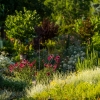Know Your Colorado Garden Pests and Pals

Rocky Mountain Gardening Elective
Attention bug lovers and bug haters! Knowledge of your garden and landscape pests and pals can make a big difference in peace of mind. Join Whitney Cranshaw, emeritus professor of entomology at Colorado State University, author of “Bugs Rule!” and captivating speaker to learn about our Front Range insects – friends and foes. Discover secrets and tricks for promoting beneficial insects and controlling pests in your garden. Develop an understanding of the significant role these little critters play in our ecosystem. This series teaches how to effectively work with insects and natural methods of pest management. Enjoy learning about little-known aspects of the Front Range ecosystem. Take just one or take them all!The Invasive Japanese Beetle and Emerald Ash Borer
Saturday, June 28, 9:30 - 11:30 a.m. Learn about two of Colorado’s most destructive invasive pests and ways to manage the impacts. Over the past decade Japanese beetle has emerged as serious new pest in many parts of Colorado and is steadily extending its range within the state. Adults chew on the leaves and flowers of a very wide variety of landscape plants commonly grown in the region. Better understanding the habits of this insect is fundamental to best managing it. Learn about the methods that can be used against them, including cultural controls, biological controls and selective chemical controls. The emerald ash borer, first detected in North America in 2002, has proven to be the most destructive insect pest to ever have entered the United States. Colorado joined the emerald ash borer club in 2013 when it was first detected in Boulder. In the past two decades, hundreds of millions of ash trees have been killed over broad areas of the country. Learn how this insect develops, damages trees and spreads. Understand the current research available and management options for Colorado’s ash population.Colorado Wasps!
Saturday, July 12, 9:30 - 11:30 a.m. For many people, thinking of wasps brings to mind something like a pesky yellowjacket that disrupts outdoor dining or perhaps the “murder hornet” that made a splash in the news a couple of years ago. But there are hundreds of kinds of insects found in Colorado that are called wasps, and they vary enormously in habits. Some sting, many do not, and some are highly beneficial to gardeners. Learn about Colorado wasps so you can recognize them, better understand how they live and what they do, and, if necessary, how to manage them.Gardening for Insects – or Not!
Saturday, July 19, 9:30 - 11:30 a.m. The benefits of improving habitat for various “beneficial” or desirable kinds of insects has increasingly been recognized. Learn the details of how to adapt and effectively apply these types of practices to your garden and landscape’s local conditions. Take away a plan for how to build up populations of a wide range of “good bugs” in the region – from butterflies and “hummingbird moths” to various kinds of bees and natural enemies of insect pests. Additionally, discussion covers what can be done to avoid a few that are less desirable.Guess Who Came to Dinner – Signs Plant Feeding Insects Leave Behind
Saturday, August 2, 9:30 - 11:30 a.m. Diagnosis of insect injuries to plants can often be difficult. Often the insects are no longer present when the injury is noted, and many are quite small, such as mites. The kinds of injuries produced can be characteristic of one kind of insect or another, based on their feeding habits and the plant response to injury. Furthermore, insects and mites leave behind clues in the form of discarded eggshells and body parts, waste products or secreted materials such as silk or wax. Learn to recognize which insects feed using chewing mouthparts versus insects and mites that feed on the fluids from plants in order to develop effective controls.Price: $44, $38 member
Location: York Street
Instructor: Dr. Whitney Cranshaw
Dr. Whitney Cranshaw is an Emeritus Professor of Entomology at Colorado State University where he has worked since 1983. During this time he has conducted a wide-ranging Extension/Research/Teaching program with the primary focus of improving the understanding of and effective management of insects of horticultural crops (vegetables/fruits, flowers, trees/shrubs, turfgrass, hemp). He has written extensively on these subjects, producing many hundreds of publications on research and for public education/Extension. He has also authored several books, perhaps best-known being Garden Insects of North America and Bugs Rule! An Introduction to the World of Insects. His work has been recognized by numerous awards associated with various “green industries” and professional associations, within the state and nationally. Although retired from CSU in July 2020, he has not retired from “bugs” and continues to write, speak with diverse audiences, support websites and listserv discussion groups, and conduct research on projects of interest.